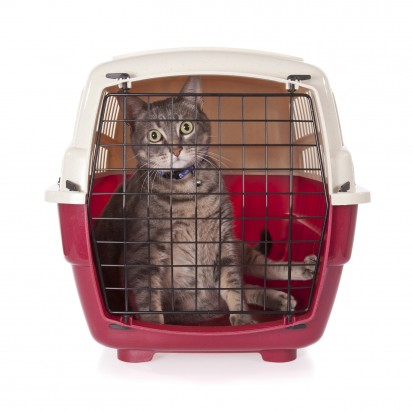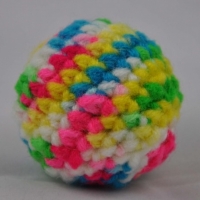

Getting your cat to accept being put into a cat carrier and transported may seem like an impossibility, and loading your cat up for a trip to the vet, a house move or any other time that you need to transport your cat can be very stressful and difficult for many cats and owners.
However, there is no getting away from the fact that every cat will need to be boxed up and transported at some point in their lives, and doing this with the minimum amount of stress, fuss and difficulty is of course the preferable way to go about things! If you are wondering how to get your cat used to the cat carrier and what you can do to make transporting your cat less stressful, read on for our top tips.
When we talk about cat carriers, most of us visualise the standard sturdy plastic boxes with a front-opening wire gate, or one of the larger metal cages that are sometimes used for both cats and dogs. But there are many other alternative and more modern options available for transporting your cat, and you may find that a different type of carrier may make your cat feel more at home and comfortable, and make loading and transporting them less stressful. Some options to consider include top-loading carriers, carriers that come in the form of a wheel-along pram or pushchair rather than a box, and sturdy fabric carriers that can be worn across the chest as a papoose, allowing your cat’s head to peek out while they are securely clipped into the carrier via a short lead on their collar or harness.
Shop around; there are plenty of options out there! Just make sure that your carrier is strong enough and sturdy enough to contain your cat, and has a securely fastening door that your cat cannot open on their own!
If your cat only sees the carrier when you produce it suddenly, bundle them into it and cart them off to somewhere unpleasant like the vets, your cat will almost certainly be reluctant to get into it and go. Cats also dislike feeling enclosed, and trying out some of the alternative types of carriers mentioned above can help with this. If your cat has previously had a bad experience with the carrier, such as being knocked about when driving or being barked at by a dog while at the vets, you will have to work harder to improve how they feel about the carrier itself and how willing they are to accept it.
If your cat had a particularly bad time in one specific carrier, there is a lot of merit to the idea of replacing it for a new one and starting afresh. This is particularly a good idea if your cat went to the toilet in the carrier, as this is almost always a stress reaction and the carrier will continue to smell after the event to your cat, even after cleaning.
Your cat carrier should be suitably padded out with comfortable bedding to keep you cat safe and protected. Many cats will wish to hide while in the carrier, so also include a light loose blanket on the top of the other padding so that your cat can burrow under it if they want to.
If possible, keep your cat carrier out in the open within the home at all times, and certainly for a period of time leading up to any planned journeys. This will allow your cat to get used to it and view it as a normal part of the furniture and not as something unusual and threatening. It will also allow the carrier to become infused with the normal smells of the household, and not smell alien to your cat and add to their discomfort.
Try feeding your cat within their carrier if at all possible, as this will encourage your cat to go into the carrier of their own volition and build up positive associations with the container. Do not surprise your cat by closing the door on them suddenly or without warning, although it can also be helpful to get your cat used to being in the carrier for short periods of time with the door closed, before being let back out.
Feliway is a synthetic pheromone that mimics the feel-good pheromone that cats themselves produce, and can go a long way towards making an anxious or unsettled cat feel more comfortable. Use a Feliway spray in the container and on the bedding within it, refreshing it regularly as the spray only remains effective for a few hours at a time.
Catnip, should your cat enjoy it, can also be helpful at encouraging your cat into the container of their own volition for trial runs, but should not be used at the time that you actually intend to transport your cat within the container, as this additional stimulus can add an extra source of stress.
While most of the time, trips in the cat carrier are carefully planned in advance, don’t forget that in the event of an emergency (such as if your cat becomes sick or injured without warning) you will need to be able to locate and use you carrier in a hurry. If your carrier does not get left out in the open and easily to hand when not in use, make sure that you keep it easily accessible in a cupboard or other area that you can get to easily if needed. Keep it padded, comfortable and all ready to receive your cat; and remember where you left it!
It is important to drive carefully and slowly when your cat is in the car, to avoid scaring or stressing them with a lot of bumping around or movement. Cats can get carsick, and even cats that do not feel nauseous in the car will almost certainly find the sensation of being on the move disconcerting. If possible, take a few short dry-run journeys in the car at non-essential times when you don’t need to be anywhere, to get your cat used to the sensation of being on the move and able to get used to being carried about in a low-stress situation.
Finally, remember to secure the carrier in the car with a seatbelt, in order to help to protect your cat in the event of any sudden stops or problems.
 Treatment Options For Hip Dysplasia In Dogs
Treatment Options For Hip Dysplasia In Dogs
 How To Handle Your New Puppy’s First Night With You
How To Handle Your New Puppy’s First Night With You
 English Toy Terrier Hereditary Health And Longevity
English Toy Terrier Hereditary Health And Longevity
 Five More Common Mistakes To Avoid Making With Your New Puppy
Five More Common Mistakes To Avoid Making With Your New Puppy
 Five Universal Personality Traits Of The Jack Russell Terrier
Five Universal Personality Traits Of The Jack Russell Terrier
 What To Look For When Choosing A Catnip Cat Toy
What To Look For When Choosing A Catnip Cat Toy
 Can You Stop Your Dog From Snoring?
Can You Stop Your
Can You Stop Your Dog From Snoring?
Can You Stop Your
 English Toy Terrier Hereditary Health And Longevity
English Toy Terri
English Toy Terrier Hereditary Health And Longevity
English Toy Terri
 Pet Cloning - Is It Viable And Ethical?
Pet Cloning - Is
Pet Cloning - Is It Viable And Ethical?
Pet Cloning - Is
 Getting Children Involved In Cat Care
Getting Children
Getting Children Involved In Cat Care
Getting Children
 Why Might Your Dog Be Licking Their Paws Obsessively?
Why Might Your Do
Why Might Your Dog Be Licking Their Paws Obsessively?
Why Might Your Do
Copyright © 2005-2016 Pet Information All Rights Reserved
Contact us: www162date@outlook.com